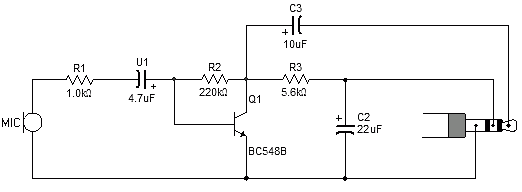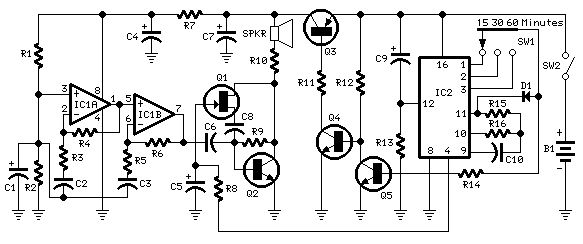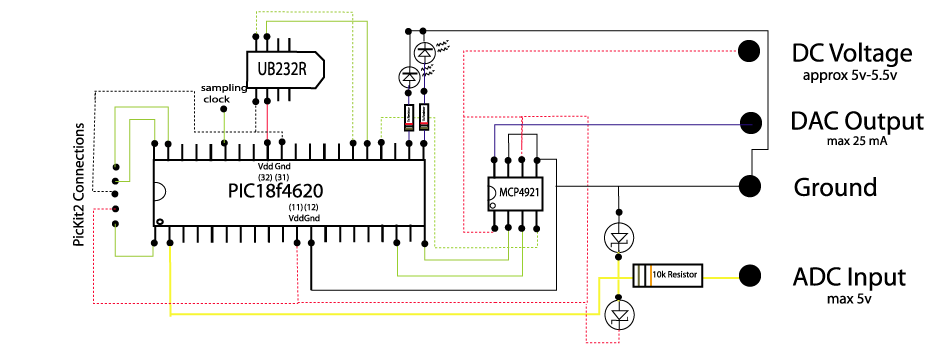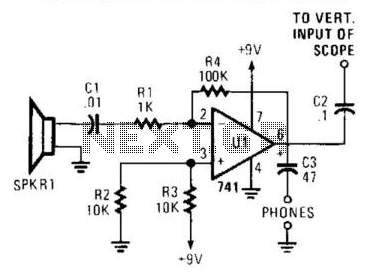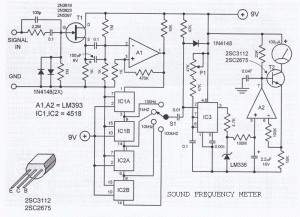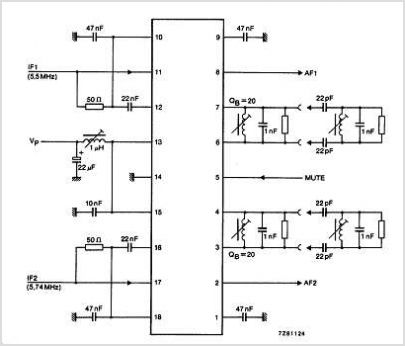
sound capture
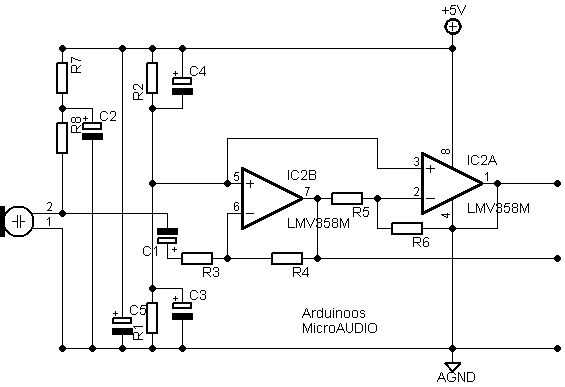
After conducting new experiments on sound analysis, a different design for the microphone amplifying section has been developed. The entire circuit is powered by a clean voltage supply ranging from +5V to +12V, which is filtered by capacitor C5. The electret type microphone is biased through resistors R7 and R8, with a filtering capacitor C2 employed to eliminate power supply noise. The active pin of the microphone connects to the first stage of an inverting amplifier (IC2B) via a decoupling capacitor, which allows AC components of the signal to pass while blocking the DC component. The gain of this amplifier is determined by resistors R3 and R4, with the gain expressed as G = R3/R4. The non-inverting input of the amplifier is set to a virtual ground at half the value of VCC (typically 2.5V for a 5V supply), ensuring that the signal at rest is approximately half VCC and oscillates around this value. The division of VCC is achieved through the resistor divider R1/R2, stabilized by capacitors C3 and C4. Omitting these capacitors may result in an unstable output. The output of this stage is accessible at pin 7 of IC2B. Some applications may necessitate a higher gain, which is accomplished by introducing a second amplifying stage that mirrors the design of the first stage; its gain is set by resistors R5 and R6 (note: R6 is marked with an erratic spot and should not be connected to ground). This second stage shares the same virtual ground as the first stage. The overall gain of the amplifier is the product of the gains from both stages. Using two stages rather than a single high-gain stage is crucial to avoid exceeding the bandwidth limit of the operational amplifier at the highest frequency encountered by the circuit. While practical circuits can achieve gains of 100, higher gains may lead to oscillation unless special care is taken during the PCB layout. Cascading two or more equal-gain stages is preferable to attempting high gain in a single stage.
The microphone amplifying circuit described operates effectively within the specified voltage range of +5V to +12V, ensuring compatibility with various power supply configurations. The use of an electret microphone is advantageous due to its low power consumption and adequate sensitivity for sound capture applications. The biasing arrangement provided by resistors R7 and R8 ensures that the microphone operates within its optimal range, while capacitor C2 effectively filters out any noise present in the power supply, enhancing the overall signal quality.
The first stage of amplification utilizes an inverting operational amplifier configuration, which is common in audio applications due to its ability to amplify weak signals effectively. The gain is adjustable through resistors R3 and R4, allowing for flexibility based on application requirements. The implementation of a virtual ground at half the supply voltage is a critical design choice, as it centers the output signal around a reference level, facilitating more straightforward processing in subsequent stages.
The second amplification stage mirrors the design of the first, reinforcing the signal further. The decision to use two stages rather than a single high-gain stage is a strategic choice to maintain stability and bandwidth, crucial for high-frequency applications. The overall design prioritizes stability and performance, ensuring that the amplifier can handle the demands of various sound analysis tasks without introducing distortion or oscillation.
In summary, this microphone amplifying circuit design is a robust solution for sound analysis, providing adjustable gain, noise filtering, and stability across a range of operating conditions. The careful consideration of component values and configurations ensures that the circuit can perform effectively in real-world applications.After some new experiments on sound analysis, I used a different design for the microphone amplifying section, that I am happy to share with you (From the statistics of Arduinoos, I know that sound capture is a topic of major interest for many of you). The whole circuit is supplied with a clean +5 to +12V, filtered by C5. The microphone (electret t ype) is biased through R7, R8, using a filtering capacitor C2 for removing some power supply noise. The active pin of the micro phone is connected to the first stage of an inverting amplifier (IC2B) via a decoupling capacitor which stops the DC component of the signal and all the AC component to go through. The gain of this amplifier is set by R3 and R4, with G=R3/R4. The non inverting input of the amplifier is set to avirtualground at half the value of VCC (typcally 5/2=2.
5V), so that the signal at rest is about half VCC and swings around this value. Halving VCC is performed by the divider bridge R1/R2, stabilized by C3 and C4. Lacking to install thesecapacitors may lead to an unstable output. The output of this stage is available at pin 7 of IC2B. Someapplicationsmay require an even higher gain, which is achieved by a second amplifying stage. This second stage uses exactly the same design than for the first stage; its gain is set by R5 and R6 [erratic spot on R6 and GND: do not connect]. It shares the same virtual ground as for the first stage. The total gain of the amplifier is the product of the gains from the two stages. BTW, why would we use two stages It is very important not to violate the bandwidth limit of the op amp at the highest frequency seenby the circuit.
Practical circuits can include gains of 100, but higher gains could causethe circuit to oscillate unless special care is taken during PC board layout. It is better to cascadetwo or more equal-gain stages than to attempt high gain in a single stage. 🔗 External reference
The microphone amplifying circuit described operates effectively within the specified voltage range of +5V to +12V, ensuring compatibility with various power supply configurations. The use of an electret microphone is advantageous due to its low power consumption and adequate sensitivity for sound capture applications. The biasing arrangement provided by resistors R7 and R8 ensures that the microphone operates within its optimal range, while capacitor C2 effectively filters out any noise present in the power supply, enhancing the overall signal quality.
The first stage of amplification utilizes an inverting operational amplifier configuration, which is common in audio applications due to its ability to amplify weak signals effectively. The gain is adjustable through resistors R3 and R4, allowing for flexibility based on application requirements. The implementation of a virtual ground at half the supply voltage is a critical design choice, as it centers the output signal around a reference level, facilitating more straightforward processing in subsequent stages.
The second amplification stage mirrors the design of the first, reinforcing the signal further. The decision to use two stages rather than a single high-gain stage is a strategic choice to maintain stability and bandwidth, crucial for high-frequency applications. The overall design prioritizes stability and performance, ensuring that the amplifier can handle the demands of various sound analysis tasks without introducing distortion or oscillation.
In summary, this microphone amplifying circuit design is a robust solution for sound analysis, providing adjustable gain, noise filtering, and stability across a range of operating conditions. The careful consideration of component values and configurations ensures that the circuit can perform effectively in real-world applications.After some new experiments on sound analysis, I used a different design for the microphone amplifying section, that I am happy to share with you (From the statistics of Arduinoos, I know that sound capture is a topic of major interest for many of you). The whole circuit is supplied with a clean +5 to +12V, filtered by C5. The microphone (electret t ype) is biased through R7, R8, using a filtering capacitor C2 for removing some power supply noise. The active pin of the micro phone is connected to the first stage of an inverting amplifier (IC2B) via a decoupling capacitor which stops the DC component of the signal and all the AC component to go through. The gain of this amplifier is set by R3 and R4, with G=R3/R4. The non inverting input of the amplifier is set to avirtualground at half the value of VCC (typcally 5/2=2.
5V), so that the signal at rest is about half VCC and swings around this value. Halving VCC is performed by the divider bridge R1/R2, stabilized by C3 and C4. Lacking to install thesecapacitors may lead to an unstable output. The output of this stage is available at pin 7 of IC2B. Someapplicationsmay require an even higher gain, which is achieved by a second amplifying stage. This second stage uses exactly the same design than for the first stage; its gain is set by R5 and R6 [erratic spot on R6 and GND: do not connect]. It shares the same virtual ground as for the first stage. The total gain of the amplifier is the product of the gains from the two stages. BTW, why would we use two stages It is very important not to violate the bandwidth limit of the op amp at the highest frequency seenby the circuit.
Practical circuits can include gains of 100, but higher gains could causethe circuit to oscillate unless special care is taken during PC board layout. It is better to cascadetwo or more equal-gain stages than to attempt high gain in a single stage. 🔗 External reference
